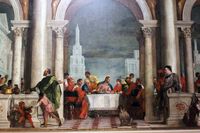Art and culture in Venice
Western art combined with Byzantine elements
Beautiful buildings and art can be seen throughout Venice. The lagoon city is itself a work of art. Beyond this, Venice hosts an unusually large number of art treasures. This is due on the one hand to the city’s exposed position and on the other to the prosperity not only of the ruling doge, but also the disproportionate number of wealthy citizens and noble families. Thanks to the commitment of the Doge republic especially in the eastern Mediterranean region and the close connection to eastern Rome you can also find lots of Byzantine elements in the city. These elements, among others, are the things that make art in Venice so unique.
The influence of Byzantine art
You do not have to search for long in Venice to discover the close connection between Venetian and Byzantine art. The mere sight of St. Mark’s Basilica with its five domes and numerous Byzantine mosaics clearly shows the influence of Byzantine art in Venice. Byzantine mosaicists worked here together with Italian artists and assistants on these artworks. Even the iconography is strongly oriented towards the model of eastern Rome. The Byzantine influence is very strong especially in Romanesque art, and is instantly recognisable everywhere in Venice to those who are no great experts. Domes, mosaics, sculptures, Byzantine spoils and many other elements bear witness to the Byzantine cultural influence in Venetian art.
Gothic art in Venice
Venice’s Gothic architecture is not so strongly marked by eastern Rome – nonetheless, Byzantine influences are decisive. Gothic art is easily recognisable to visitors on the facades of many buildings. Officially, there is just one palace in Venice – Palazzo Ducale – the buildings, modestly called “Casa” (= house – the Italian acronym for this is Ca’) by the nobles and wealthy citizens Casa are very similar to palaces. The Ca’ d’Oro has probably the most famous palace facade in late Gothic style. But a number of churches, like the Santa Maria Gloriosa dei Frari and the Santi Giovanni e Paolo, also number among the greatest examples of the late Gothic period in Venice.
Renaissance art in Venice
Architecturally speaking, not much changed in Venice during the Renaissance – at least in the area of sacred architecture. To be mentioned here are only the facades of Il Redentore, San Francesco and San Giorgio Maggiore churches, which the famous master Palladio designed himself. However, during this period many Renaissance palaces were built by wealthy families, who could afford them thanks to the wealth of the trading power of Venice. The influence of the Renaissance on painting was considerably more important. Great artists such as Jacopo and Gentile Bellini, Giorgione, Titian, Tintoretto and Paolo Veronese supplied the Doge and the numerous churches, noblemen and wealthy citizens with their works of art.
In the following centuries it was primarily Giovanni Battista Tiepolo and his son Domenico who significantly influenced Venetian art. The Santa Maria della Salute, the most important Baroque church in Venice, was finally built in the 18th century. Due to limited space, the city was largely spared large construction projects and new buildings and has been able to retain its traditional character to this day.




Tweet